Back to Hell, the second DLC for Steel Division: Normandy 44, will feature 4 new divisions, 2 exclusive ace models, as well as 7 historical missions, including 5 in cooperative play. Let’s focus today on the unsung band of pirates who, unbeknown to most, were the first men to come into action as part of Operation Overlord: the French Demi-Brigade SAS in Britanny.
WHAT IN HELL IS A DEMI-BRIGADE?
A demi-brigade (literally, “half-brigade“) is a term appearing during the French Revolution to designate a regimental-size infantry unit. Since the old Royal Army’s regiments were regarded as reactionary organizations by the new Republican government, the latter created a new structure of roughly the same size called “demi-brigade”, since two of them regrouped were to form an infantry brigade. Napoléon later abolished the name, reinstating the old “regiment” designation. Yet, “demi-brigade” endured in the form of a designation for provisional units usually made up of two battalions, especially with the Chasseurs Alpins (mountain infantry) and Légion Etrangère.
ORIGINS OF THE FRENCH SAS
Just like everybody else in 1940, General De Gaulle, although in exile in London, realized the major role played by the German paratroopers in the “Blitzkrieg” campaigns in France, Belgium, Netherlands & Norway. Therefore, he ordered in September 1940 to form an airborne 1ère Compagnie d’Infanterie de l’Air from the small pool of Forces Françaises Libres (FFL, meaning “Free French Forces” and not “French Foreign Legion”) which had joined him in the UK. One month later, 50 volunteers, mostly young men with more adventurous spirit than combat experience, had answered the call under the command of capitaine Bergé. They trained in airborne tactics and covert warfare with the British before taking part in sabotage or intelligence gathering operation in occupied France. On June 1941, two third of the company was transferred to the Middle-East, while the rest remained in England with the SOE.
Bergé and his FFL paratroopers sailed to Suez in July 1941 but too small to be worth a combat operation for the British and too precious to be wasted as mere infantry for De Gaulle, they spent the next six months champing at the bit, moving around between Egypt & Lebanon without taking part in any fight. Now designated 1ère Compagnie de Chasseurs Parachutistes (CCP), their fate took an unexpected turn when a very unconventional British Major Stirling took upon himself to approach De Gaulle with a request. David Stirling, the father of the Special Air Service, had been operating a small group of raiders for six months already but was desperately short of personnel since the British Army wasn’t very keen on giving him any. He was, therefore, focusing on foreign contingents, especially survivors from the Crete evacuation separated from their units, hence why Australians, New-Zealanders & Greeks formed such a large part of the initial SAS groups. Learning about the unused French paratroopers, Stirling asked De Gaulle if he could “borrow” them. But as with anything De Gaulle-British related, things went far from well, the French general opposing a flat refusal, adamant that no French troops shall be placed under the authority of a British officer. Legends have it that De Gaulle reconsidered his position upon learning that Stirling was a Scot, not an Englishman, and therefore honored what he considered the “oldest alliance in the world” between France & Scotland! But the patience and diplomatic talents of general Catroux, as often, are more surely to thank for that.
From January 1942, the 1ère CCP passed entirely under Stirling’s command as the 3rd SAS Squadron, more commonly referred to as the French Squadron. In June and July, they took an active part in the raids against German airfields in Cyrenaica, including the famous raid against Sidi Haneish airfield, and Crete, where Bergé was captured. After the Second Battle of El Alamein, with Rommel in full retreat, the SAS were unleashed in the desert with the mission of harassing and delaying his columns. The pursuit took a heavy toll on the SAS, whatever their ranks and nationality: Stirling & Jordan, who had taken over the French Squadron from Bergé, were captured and only three French SAS patrols were still operational when General Montgomery linked up in Tunisia with the British, American & French troops coming from Algeria.BACK TO ENGLAND
Just after the end of the campaign in Tunisia, the survivors from the French SAS Squadron were regrouped and sent back to the UK where together with the SOE operatives & new volunteers escaped from occupied France, they were reorganized on July 1st, 1943 as the 1er Bataillon d’Infanterie de l’Air (BIA), renumbered 4e BIA from November 1943. Meanwhile, a 3e BIA was created at the same time with French volunteers from Egypt & Algeria.
The two airborne battalions trained for a year in Scotland with the British & Polish paratroopers, as well as with the SAS. On April 1st, 1944, 3e & 4e BIA were officially attached to the SAS Brigade as, respectively, the 3rd & 4th SAS Regiment, while at the same time being reorganized within the French Army as, respectively, the 3e & 2e Régiment de Chasseurs Parachutistes (hence 3e BIA –> 3rd SAS/3e RCP and 4e BIA –> 4th SAS/2e RCP … easy!). While 1st & 2nd SAS Regiment were British and 5th SAS Regiment was Belgian, 3rd & 4th SAS Regiment together formed the Demi-Brigade SAS or DBSAS.On May 27th, 1944, the Demi-Brigade was placed on alert under the command of Pierre-Louis Bourgoin, commander of 4th SAS. They were to be the first Allied troops to go into battle as part of Operation Overlord.
QUI OSE GAGNE!
Let’s consider one moment Pierre-Louis Bourgoin, nicknamed for a self-explanatory reason “Le Manchot” (meaning “One-Armed Man”). Nothing destined this school teacher in French Central Africa with a passion for big game hunting to become a soldier. Yet, as soon as De Gaulle broadcasted his Appeal of 18 June, he joined the Free French as an infantry lieutenant. Serving with the Bataillon de Marche n°2, he fought in Syria where he got his first of many wounds. While recovering, he took an interest in flying and transferred to the FAFL (Free French Air Forces) as a pilot and was soon wounded again, a first time in flight by a bullet in the foot, a second time in a crash landing. Transferred to British Intelligence, he joined the SAS on its own and took part in several missions as one of them. During one such mission, his jeep was strafed by a German fighter and crashed in the roadside, leaving him with 37 wounds and shreds of his right arm dangling from the bone. Yet, he buried himself in the sand to avoid detection by a German patrol, only surfacing six hours later when hearing British voices! After being amputated from his arm and spending seven months in a hospital, he learned to shoot a pistol from the left hand and, despite being declared unfit for parachuting because of his handicap, joined the paratroopers. He designed a special harness allowing him to jump alone, got his paratrooper badge and took command of 4e BIA. A British Major in the airborne troops paid him that tribute: “That officer is so cut out for that job that it is indecent. I’m pretty sure he had his right arm cut-off as the final touch to perfect his character. (…) He reminds me of Captain Achab from ‘Moby Dick’. Well, Achab was amputated from the leg, but if one doesn’t get caught up in such detail …“. In a friendly gesture, the British gifted him for his combat jump in France with a unique blue-white-red chute.
On June 3rd, Bougoin and his officers were gathered for a briefing and told about Operation Overlord. Although they weren’t to fight on the main theater of the invasion, they would be the first Allied troops dropped in France as part of the operation. Their mission was to jump on June 5th, not in Normandy itself but in neighboring Britanny, and to fix there as many divisions from the German Seventh Army as possible, preventing or at least delaying them from reinforcing the troops fighting the main Allied invasion. They were also to make the German believe in the possibility of a second landing in Morbihan.
OPERATIONS SAMWEST & DINGSON
The French SAS, under 800 in all, weren’t dropped en masse like the Allied airborne divisions in Normandy. The plan was for a first wave of 36 SAS to jump at night and make contact with the Résistance in order to set two hidden bases of operations codenamed Samwest & Dingson, where further SAS and supplies would be dropped. At the same time, small groups of three to five men were to be dropped all over Britanny to sabotage bridges, railways, electrical or radio stations. Once their job was done, those “Cooney parties” were to fall back on either Samwest & Dingson to regroup with the main SAS forces and then operate as a guerrilla group, hitting the Germans by surprise wherever and whenever they could before disappearing, rearming, …. and so on. Finally, there were a few Allied officers dropped that night with the French SAS, in the form of Jedburgh teams: they were secret SOE operatives, usually organized into a 3-man team (most of the time, one American, one British & one French) tasked with contacting Résistance groups, evaluating their military worth and needs, delivering weapons & equipment to them by air, training and leading them into sabotage operations.
From the start, the SAS got casualties. About an hour after landing, Corporal Emile Bouétard, himself from Britanny and who had joined the FFL paratroopers because “it was the best way to arrive first in France“, was wounded in a firefight with a German patrol and finished off by an Ost soldier. Three of his comrades, captured, were delivered to the Gestapo. Their fate was to be indicative of the merciless fight in Britanny, the SAS being considered terrorists as the FFI under Hitler’s infamous Kommandobefehl: by the end of the campaign, the SAS will have a surprisingly high ratio of dead compared to wounded, for many of the latter captured by the occupiers were executed on the spot.
Alerted by the BBC‘s “personal messages” (including Verlaine’s poem “Les sanglots longs des violons de l’Automne …” informing about the imminence of the landings and “Il fait chaud à Suez” initiating guerrilla warfare), the partisans knew something big was up and their commander, Colonel Morice (Paul Chenailler’s nom de guerre) appealed on June 6th to all volunteers to gather at a farm near Saint-Marcel: the next day they would already be 3.000, with more on the way, but mostly without weapons. As soon as they made contact with the Résistance, the SAS realized the potential of the strong Briton FFI organizations and radioed London on June 8th for massive weapon and equipment drops. From a small band, the DBSAS was already growing into a small army.
The SAS and FFI immediately set to work, sabotaging infrastructures and ambushing German columns. Several more SAS groups were dropped over the next day, but the core of the DBSAS, including Bourgoin himself, jumped on June 10th: although the latter’s landing couldn’t be considered a perfect model of its type (he had to get help to untangle himself), “Le Manchot” had managed to perform his combat jump nonetheless. During the night of June 13th to 14th alone, the RAF dropped 700 containers of weapons and ammunition: although not planned, the amalgam was being made on the ground between SAS & FFI, with between 3 and 4.000 partisans equipped by mid-June. But the influx of volunteers from the Résistance was both a blessing and a curse for, as eager to fight as they were, they lacked both training and discipline and were unaware of security measures (or they just couldn’t care less). Growing over proportions, the SAS bases soon attracted German attention.
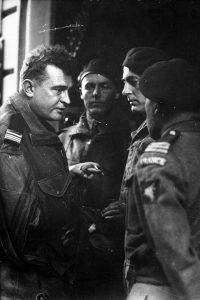
“Le Manchot” and his staff in Britanny (source Archives du Musée de la Résistance bretonne)
THE FALL OF SAMWEST
The individual initiative of an overzealous young FFI who had switched several road signs in the area to confuse the occupiers had the unexpected effect of … bringing a German staff car, completely lost, straight into the heart of Samwest on June 10th. A short firefight ensued, in which some Germans were wounded, but most others managed to escape on foot and alert a convoy arriving by the same road, as lost as their predecessors. SAS & FFI ambushed the German reinforcements, but Samwest was now compromised and had to beat off another, stronger, German attack the next day. On June 12th, Samwest was disbanded, its elements ordered to join Dingson to resume the fight. Among the casualties from those combats was Lt. André Botella, one of the first SAS to hit the ground on June 5th and to set Samwest: severely wounded, he was hidden from German searches and tended by the population, surviving and later returning to the fight. He will later make a name for himself in Indochina, being among the last men fighting at Dien Bien Phu and technically the last officer in French History to lead a battalion assault while making his men sing the Marseillaise, just like in the old Revolution days. He later ended up in disgrace for his part in the Algiers Coup against De Gaulle, that same man who had inspired him into risking his life and abandoning everything to join the Free French two decades earlier …
THE BATTLE OF SAINT-MARCEL
By now, the Germans were well aware of the SAS presence and the growing FFI activity. And they were doing everything to identify their base and strike them in the heart. To do so, the dreaded Gestapo and their French auxiliaries, the infamous Milice, arrested and interrogated hundreds of people suspected of link with the Résistance, or just entire villages located near known Résistance hideouts.
German security forces were slowly closing on the location of Dingson. Torture, execution and deportation of civilians or captured SAS were commonplace. On June 17th, the same scenario which happened at Samwest repeated itself: a two-vehicle patrol from the Feldengendarmerie got lost and ran into one of the roadblocks protecting the accesses to Dingson. All but one of the Feldgendarmen were captured or killed, but the lone survivor managed to reach friendly lines. Dingson was now also compromised. Alerted, London ordered Dingson to disperse as well, yet allowed a last drop on the base than night, delivering the DBSAS its jeep squadron (although several were damaged in the drop).
But the Germans wouldn’t let the SAS disappear once again. Mostly apathetic since the first drops, this time they reacted quickly. At 8 AM on June 18th, Osttruppen attacked and captured the village of Saint-Marcel. Lacking reliable intel, the Germans still believed they were just facing a few “bands of terrorists” and kept advancing in the woods near the village, where Bourgoin had laid an ambush. By then, he had about 3.000 men under arms in Dingson, including 200 SAS. Mowed down by accurate automatic weapons and light mortar fires, losses among the German auxiliaries quickly rose, forcing them to break off the attack. Bourgoin hoped it would give him a respite, but the Germans came back two hours later with reinforcements. By the end of the day, six infantry battalion (mostly Ostruppen) and march companies from several units, including 275. Infanterie-Division & 2. Fallschirm-Division, were engaged against Dingson.
The second assault was beaten-off short of the SAS’s HQ, this time with casualties on both sides. At 11 AM, Bourgoin asked London for air support, which came in the form of USAAF‘s P-47 strafing any approaching German columns. The American pilots managed to stay for an hour over the SAS perimeter before returning to England, running out of fuel. As soon as the plane had disappeared, the Germans renewed their attack.Despite the odds, especially in terms of heavy equipment, the SAS & FFI managed to hold the Germans at bay all day, the SAS counter-attacking wherever the Germans broke the defensive ring. When night came, Bourgoin finally gave his men the order to disperse and hide until contact was made with them again.
LIBERATION OF BRITANNY
When Dingson was abandoned and the SAS & FFI went into hiding, London also lost contact with them. In order to find out the fate of its operatives, SAS command dispatch a small group, codenamed Operation Lost, in Britanny on June 23rd. The team soon made contact with Bourgoin, and SAS operations in the region resumed. Although no large bases as Dingson & Samwest were organized again, the harassment against German troops spread all over Britanny. By August, it was estimated that 10.000 FFI had been armed and organized by the SAS & SOE and were operating in the area.
When the Americans broke the German front in Normandy at Avranches, Patton’s Third Army immediately wheeled West to liberate Britanny. On arriving there, they found most of the countryside free of Germans, the latter having fallen back on major cities & harbors, leaving the inland to the SAS and their allies. Joining the Americans, they provided them with guides & informers, leading them against German strongholds which had proven too hard a nut to crack for the lightly armed SAS & FFI.
AFTER BRITANNY
The French SAS were used in smaller operations to contact the Résistance in Eastern France before the country was entirely liberated. From then, they converted to shock troops and were engaged en masse in the Ardennes, during the Allied counter-attack. They ended the war in the Netherlands.
Although formed from other units, but containing some of the original SAS, a new 1e Demi-Brigade de Parachutistes SAS was created in 1946 and sent in Indochina. After much reorganizing, disbanding, merging, … the SAS tradition remains today in the French Army with the 1er Régiment de Parachutistes d’Infanterie de Marine (1er RPIMa).
THE DBSAS INGAME
The Demi-Brigade SAS is somehow a “division-story”, time unfolding through the different phases: first (Phase A) comes the Britton maquis, plenty of lightly armed and inexperienced FFI with a few Jedburgh & SAS scouts as cadres, waiting for the main force. Then (Phase B) the core of the elite SAS troops jumps in to hold the ground until the cavalry rushes to the rescue. The latter finally (Phase C) arrives in the form of US mechanized troops breaching through German lines to link up with the paratroopers & partisans.
Here are some of the DBSAS‘ features:
- from small arms to (a very few) armored vehicles, the FFI are equipped with a mix of civilian vehicles (including the iconic Traction), old 1940 French military equipment (25mm AA gun, Hotchkiss HMG, H-35, Panhard, B1 bis, …) either hidden or re-captured from the Germans, and captured German equipment (MG-34, Panzerfaust, side-cars & Kubelwagen, a few half-tracks, a handful of tanks, …).
- The maquis even fields some squads of Russian Ralliés, deserters from the Osttruppen which provides the Résistance with some well-armed (German style) and trained soldiers.
- a large part of the FFI troops, as well as some SAS, are recon troops, hence easy to infiltrate or leave behind enemy lines.
- the main core of SAS troops is made of elite paratroopers, hence unaffected by the frontline too. Yet, they are very lightly equipped, even for paratroopers: PIAT & 3-inch mortars being their most powerful weapons … with an occasional help from off-map naval artillery.
- aside from some Free French Westland Lysander, the famous liaison aircraft with the Résistance, air support is provided by USAAF & RAF aircrafts.
- its economy is quite low in Phase A & B, with the small band of SAS & FFI having to hold what territory they can with the few equipment they have, until the cavalry arrives in full forces in Phase C.
Steel Division: Normandy 44 – Back to Hell will be available on February 13th, and you can preorder it right here, right now.

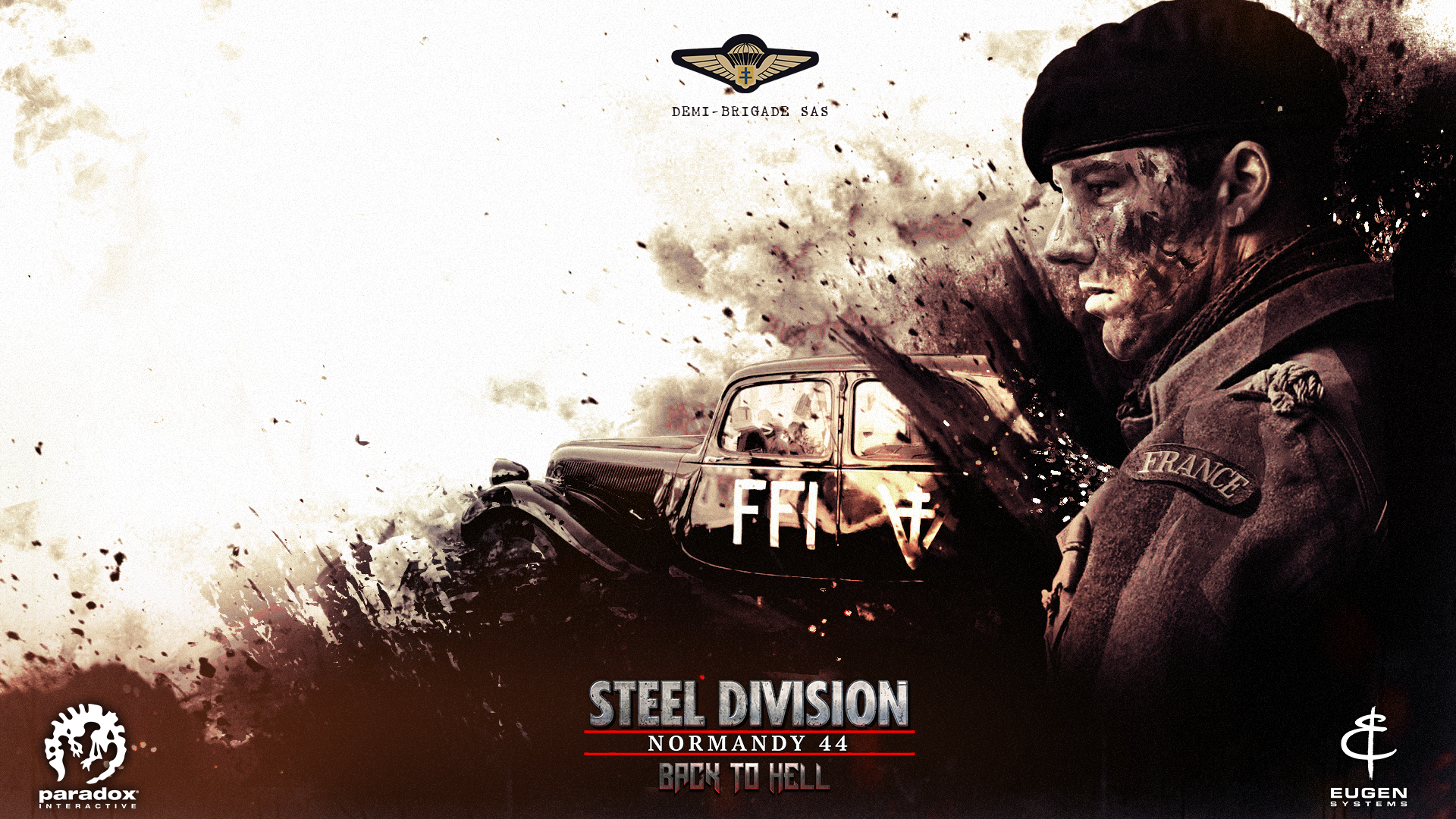
![The_Special_Air_Service_(sas)_in_North_Africa_during_the_Second_World_War_E21340[1]](https://eugensystems.com/wp-content/uploads/2018/01/The_Special_Air_Service_sas_in_North_Africa_during_the_Second_World_War_E213401-285x300.jpg)
![French_sas_north_africa_1943[1]](https://eugensystems.com/wp-content/uploads/2018/01/French_sas_north_africa_19431-300x300.jpg)
![default[1]](https://eugensystems.com/wp-content/uploads/2018/01/default1.jpg)
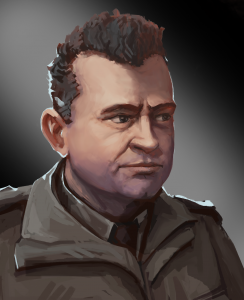

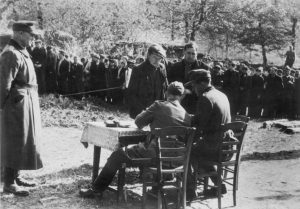
![dsh6cka[1]](https://eugensystems.com/wp-content/uploads/2018/01/dsh6cka1.jpg)

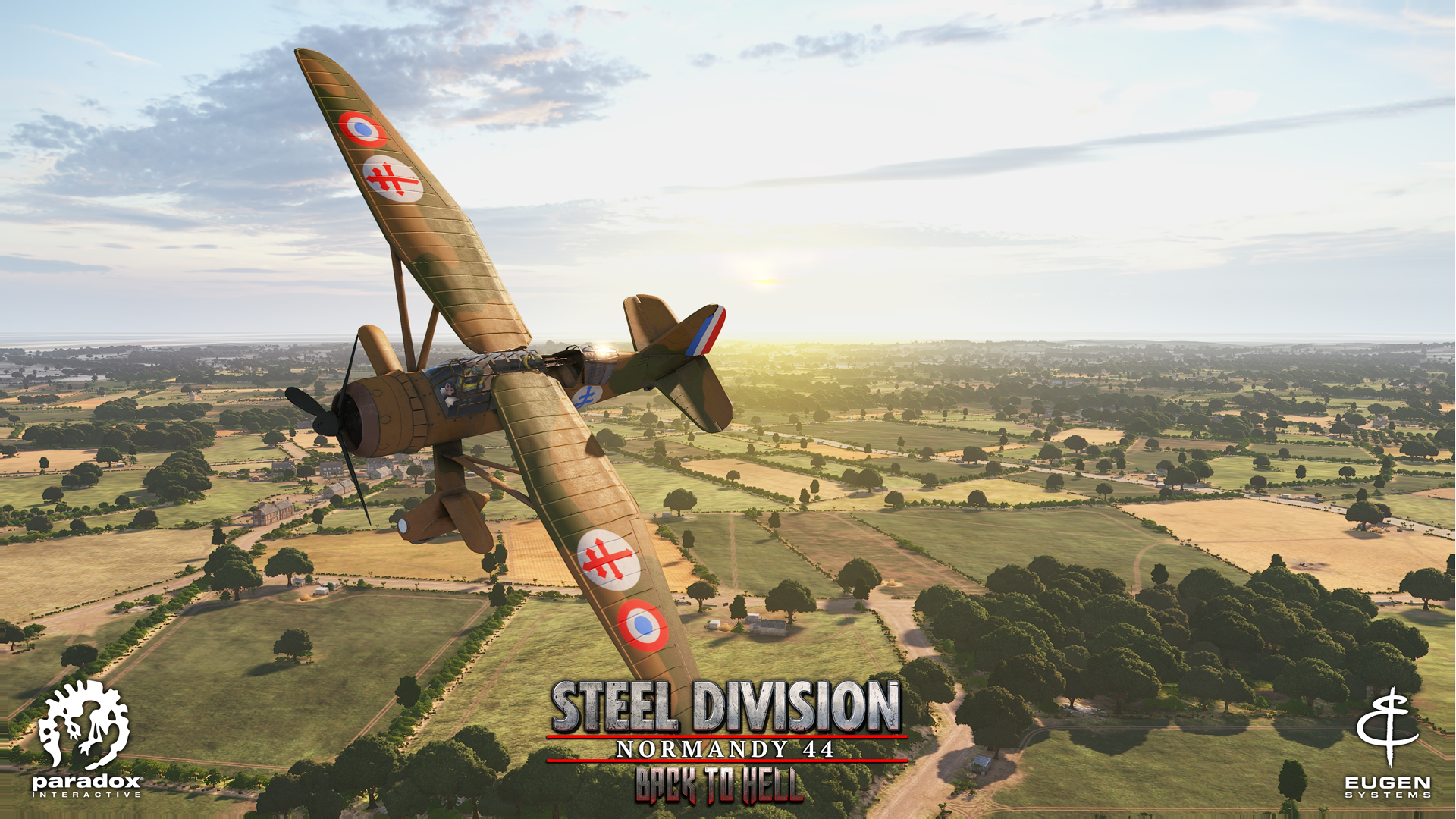


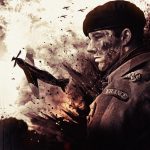
Black Hand
February 7, 2018 at 10:27 pmCould you give more info about the captured Panzer III and Jagdpanzer IV? All I found was 1 photo of a captured Jagdpanzer IV in this (french) website.
https://www.chars-francais.net/2015/index.php/8-archives/de-1940-1945/1209-1944-ffi